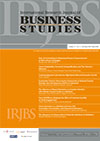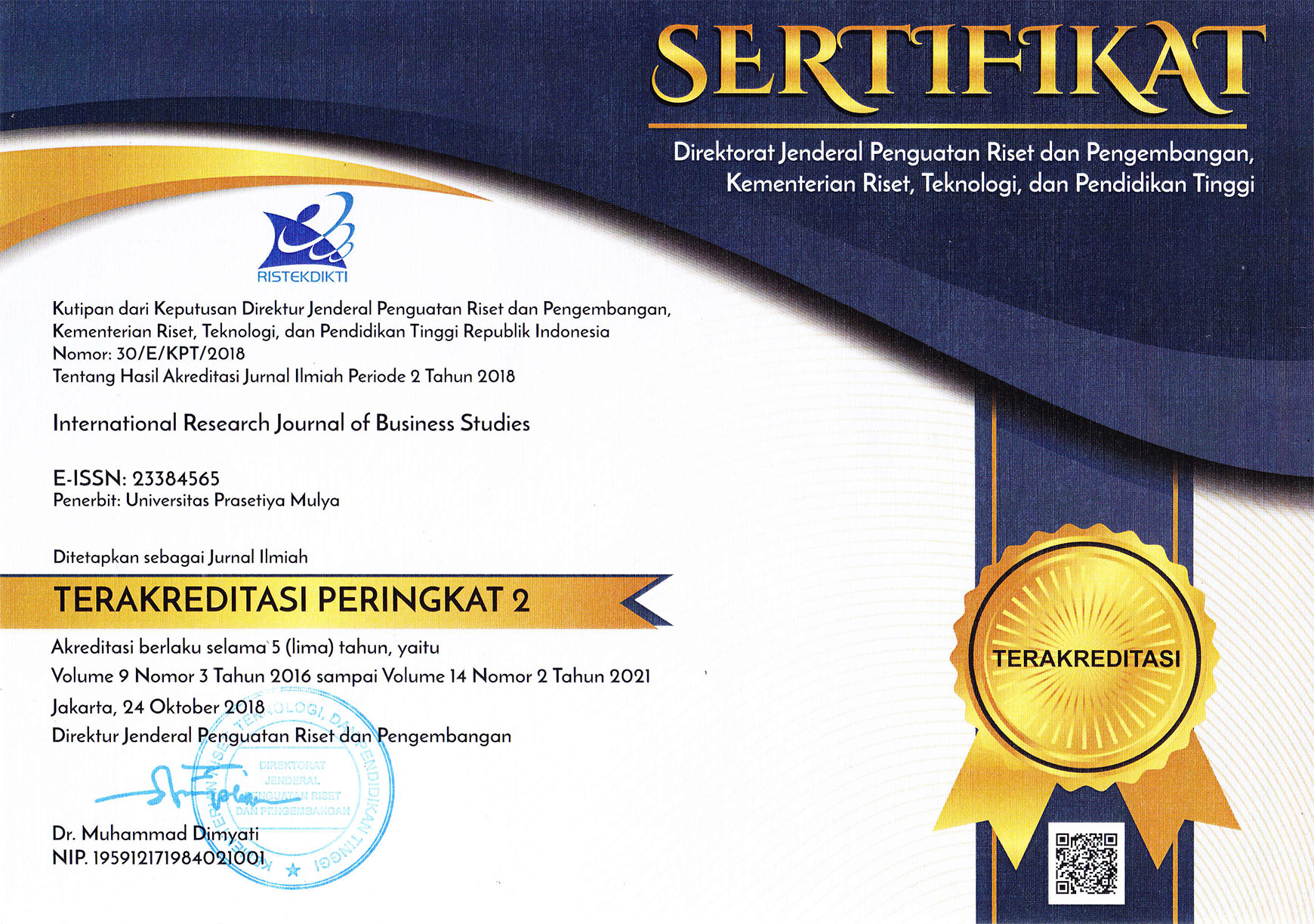How do Entrepreneurial Human Resource Practices Determine Small Firms’ Performance?
DOI:
https://doi.org/10.21632/irjbs.9.3.133-146Keywords:
entrepreneurial human resource practices, relational capability, market orientation, business performanceAbstract
This study examines the effects of entrepreneurial human resource practices on market-oriented behaviour, relational capability, and business performance at small-sized firms. For the purpose of the study, a survey was carried out for two different product types, namely handicrafts and food/drink, and sample firms were purposively selected. Interestingly, the findings suggest that, though practices may not directly improve firms’ performance, implementing practices characterised by entrepreneurial orientation is a start for high performance as market oriented behaviour and relational capability moderate the effects. The practices stimulate employees’ mind-sets, shaping their behaviour and willingness to find new ways of doing business and satisfying external customers. The implication of the study was that such practices should be designed to improve small firms’ market-oriented behaviour and relational capability for better business performance.
References
Abzari, M., Ghorbani, H., & Madani, F.A. (2011) ‘The effect of internal marketing on organisational commitment from marketorientation viewpoint in hotel industry in Iran’. International Journal of Marketing Studies, 3, ( 1), 147–155.
Baker, W.E. & Sinkula, J.M. (2009)’The complementary effects of market orientation and entrepreneurial orientation on profitability in small business’, Journal of Small Business Management, 47 (4). 443–464.
Beugelsdijk, S. (2008) ‘Strategic human resource practices and product innovation’ Organisation Studies, 29( 6). 821–847.
Chung, J., Huang, Y., Jin. B. & Sternquist, B. (2011) ‘The impact of market orientation on Chinese retailers’ channel relationships’ Journal of Business & Industrial Marketing, 26 (1) 14–25.
Conduit, J., & Mavondo, F.T. (2001) ‘How critical is internal customer orientation to market orientation?’ Journal of Business Research, 51, 11–24.
Fornell, C., & Larcker, D. F. (1981)’Evaluating structural equation models with unobservable variables and measurement error’. Journal of Marketing Research, 18 (1), 39–50.
Gounaris, S.P. (2006)’Internal market orientation and its measurement’ Journal of Business Research, 59,. 432–448.
Gonzáles-Benito, O.G. Gonzáles-Benito, J.G. & Gallego, P.A.M. (2009) ‘The role of entrepreneurship and market orientation in firms’ success’ European Journal of Marketing, 43 ( ¾) 500–522.
Grinstein,A. (2008) ‘The relationships between market orientation and alternative strategic orientations’, European Journal of Marketing, 42, (1/2), 115-134.
Hair, J.F., Black, W.C, Babin, B.J., Anderson, R.E., and Tatham, R.L. (2006), ‘Multivariate data analysis’. New Jersey: Pearson Education International.
Hakala, H. & Kohtamaki, M. (2011) ‘Configuration of entrepreneurial customer and technology orientation’, International Journal of Entrepreneurial Behaviour and Research, 17 ( 1) 64–81.
Huang, S. K. & Wang, Y. (2011) ’Entrepreneurial orientation, learning orientation and innovation in small and medium enterprises’ Procedia Social and Behavioural Sciences, 24,. 563–570.
Hunt, S.D & Arnett, D.B. (2006) ‘The explanatory foundations of relationship marketing theory’, Journal of Business & Industrial Marketing, 2, ( 2) 72–87.
Iglesias, O., Sauquet, A. & Montana, J. (2011) ‘The role of corporate culture in relationship marketing’, European Journal of Marketing, 45, (4 ) 631–650.
Jaworski, B.J. & Kohli, A. K. (1993) ‘Market Orientation: Antecedents and Consequences’, Journal of Marketing, 57 (July), 53–70.
Kropp, F. Lindsay N.J. & Shoham, A. (2006) ‘Entrepreneurial, market and learning orientations and international entrepreneurial business venture performance in South African firms’ International Marketing Review,. 23 ( 5). 504–523
Kucukkancabas, S., Akyol, A. & Ataman, B.M. (2009), ’Examination of the effects of the relationship marketing orientation on the company performance’,. Qual Quant, 43, 441–450
Li, Y., Zhao. Y. Tan, J. & Liu, Y. (2008) ‘Moderating effects of entrepreneurial orientation on market orientation-performance linkage: Evidence from Chinese small firms’, Journal of Small Business Management, 46 (1) 113–133.
Lings, I., & Greenley, G. (2009), ‘The impactof internal and external market orientations on firm performance’, Journal of Strategic Marketing, 17 ( 1). 41–53.
Liyun, Q., Keyi, W., Xiaoshu, W. & Fangfang, Z. (2008), ‘Research on the relationship among market orientation, customer relationship management, customer knowledge management and business performance’ Management Science and Engineering,2 (1). 31–37.
Macintosh, G. (2007), ‘Customer orientation, relationship quality and relational benefits to the firm’, Journal of Service Marketing, 21 (3) 150–159.
Mavondo, F.T. Chimhanzi, J. & Stewart, J. (2005), ‘Learning orientation and market orientation’. European Journal of Marketing, 39 (11/12)1235–1263.
Nasution, H.N., & Mavondo, F.T. (2008), ‘Organisational capabilities: Antecedents and implications for customer value’. European Journal of Marketing, . 42 (¾) 477–501.
Ngugi, I.K, Johnsen, R.E., & Erdelyi, P. (2010), ‘Relational capabilities for value co-creation and innovation in SMEs’. Journal of small Business and Enterprise Development, 17 (2) 260–278.
Panayides, P.M. (2007), ‘The impact of organisational learning on relationship orientation, logistics service effectiveness and performance’ Industrial Marketing Management, 36 (1) 68–80.
Rodriguez-Diaz, M., & Espino-Rodriguez, T.F. (2006a)’Developing relational capabilities in hotels’ International Journal of Contemporary Hospitality Management, 18 (1),. 25–40.
Rodriguez-Diaz, M., & Espino-Rodriguez, T.F. (2006b) ‘Redesigning the supply chain: reengineering. outsourcing and relational capabilities’. Business Process Management. 12( 4) 483–502.
Slater S.F. & Narver, J.C. (1995), ‘Market orientation and the learning organisation’ ,Journal of Marketing, 59 (July), 63–74.
Sulhaini (2012), ‘Understanding business relationship development in the context of a high-risk and uncertain country market’ Journal Ventura, 15,(1). 1–16.
Smirnova, M., & Kushch, S. (2006, September). Understanding the role of relational capabilities in buyer-seller relationships. Paper presented at the 22nd IMP-conference in Milan, Italy.
Smirnova, M., Naude, P., Mouzas, S., Kouchth, S.P. (2009)), ’Market orientation driving relational capabilities development?’ The case of Russian industrial firms. Paper presented at the 25th IMP Conference, September, Marseille, France.
Smirnova, M., Naude, P., Henneberg, S.C. Mouzas, S., & Kouchth, S.P. (2011), ‘The impact of market orientation on the development of relational capabilities and performance outcomes: The case of Russian industrial firms’, Industrial Marketing Management, 40, 44–53.
Uyar, A.S., & Deniz, N. (2012), ‘The perceptions of entrepreneurs on the strategic role of human resource management’, Procedia – Social and Behavioural Sciences, 58, 914–923.
Voss, K., Johnson, J.L. Cullen J.B., Sakano, T., & Takenouchi, H. (2006), ‘Relational exchange in US–Japanese marketing strategic alliances’, .International Marketing Review, 23, ( 6), 610–635.
Wengel, J.T.& Rodrigues, E.(2006), ‘SME export performance in Indonesia after the crisis’, .Small Business Economics, 26 (1). 25–37.
Downloads
Submitted
Published
How to Cite
Issue
Section
Categories
License
Copyright (c) 2016 Sulaimiah, Sulhaini

This work is licensed under a Creative Commons Attribution-ShareAlike 4.0 International License.
Journal Author(s) Rights
For IRJBS to publish and disseminate research articles, we need publishing rights (transferred from the author(s) to the publisher). This is determined by a publishing agreement between the Author(s) and IRJBS. This agreement deals with the transfer or license of the copyright of publishing to IRJBS, while Authors still retain significant rights to use and share their own published articles. IRJBS supports the need for authors to share, disseminate and maximize the impact of their research and these rights, in any databases.
As a journal Author, you have rights to many uses of your article, including use by your employing institute or company. These Author rights can be exercised without the need to obtain specific permission. Authors publishing in IRJBS journals have comprehensive rights to use their works for teaching and scholarly purposes without needing to seek permission, including:
- use for classroom teaching by Author or Author's institution and presentation at a meeting or conference and distributing copies to attendees;
- use for internal training by the author's company;
- distribution to colleagues for their research use;
- use in a subsequent compilation of the author's works;
- inclusion in a thesis or dissertation;
- reuse of portions or extracts from the article in other works (with full acknowledgment of the final article);
- preparation of derivative works (other than commercial purposes) (with full acknowledgment of the final article);
- voluntary posting on open websites operated by the author or the author’s institution for scholarly purposes,
(But it should follow the open access license of Creative Common CC-by-SA License).
Authors/Readers/Third Parties can copy and redistribute the material in any medium or format, as well as remix, transform, and build upon the material for any purpose, even commercially. Still, they must give appropriate credit (the name of the creator and attribution parties (authors' detail information), a copyright notice, an open access license notice, a disclaimer notice, and a link to the material), provide a link to the license, and indicate if changes were made (Publisher indicates the modification of the material (if any) and retain an indication of previous modifications.
Authors/Readers/Third Parties can read, print and download, redistribute or republish the article (e.g. display in a repository), translate the article, download for text and data mining purposes, reuse portions or extracts from the article in other works, sell or re-use for commercial purposes, remix, transform, or build upon the material, they must distribute their contributions under the same license as the original Creative Commons Attribution-ShareAlike (CC BY-SA).
This work is licensed under a Creative Commons Attribution-ShareAlike 4.0 International License.








